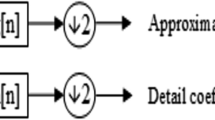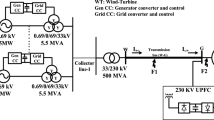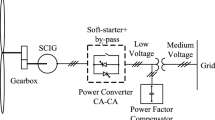Abstract
This paper proposes a condition monitoring technique using current signature analysis for diagnosis of Rotor eccentricity fault in Squirrel cage induction generators used in wind power systems. The proposed method measures the current characteristic frequencies of the excitations generated by a Wind turbine generator. The excitations generated by wind turbine generator eccentricity fault are extracted and analyzed under no load, full load and varying wind conditions. Side bands are calculated using FFT approach. Fault frequencies are further analyzed using wavelet-based analysis for steady state and dynamic conditions. Multi-resolution mean power indicator has been used for the quantification of the fault. It has been experimentally proven that for varying wind conditions wavelet decomposition allows good differentiation between faulty and healthy conditions leading to an effectual diagnostic procedure for condition monitoring.














Similar content being viewed by others
References
Liu, W.Y., Tang, B.P., Han, J.G., Lu, X.N., Hu, N.N., He, Z.Z.: The structure healthy condition monitoring and fault diagnosis methods in wind turbines: A review. Renew. Sustain. Energy Rev. 44, 466–472 (2015)
McMillan, D., Ault, G.W.: Condition monitoring benefit for onshore wind turbines: sensitivity to operational parameters. IET Renew. Power Gener. 2, 60–72 (2008)
Ribrant, J., et al.: Survey of failures in wind power systems with focus on swedish wind power plant during 1997–2005. IEEE Trans. Energy Convers. 22(1), 167–173 (2007)
Tavner, P.J., et al.: Reliability analysis for wind turbines. J. Wind Energy 10(1), 1–18 (2006)
Abeygunawardane, S.K., Jirutitijaroen, P.: A Markov model for a wind energy conversion system with condition monitoring. In: IEEE Conference Publications-TENCON (2009)
Djurovic, S., Crabtree, C.J., Tavner, P.J., Smith, A.C., et al.: Condition monitoring of wind turbine induction generators with rotor electrical asymmetry. IET Renew. Power Gener. 6(4), 207–216 (2012)
Soua, S., Van Lieshout, P., Perera, A., Gan, T.-H., Bridge, Bryan: Determination of the combined vibrational and acoustic emission signature of a wind turbine gearbox and generator shaft in service as a pre-requisite for effective condition monitoring. Renew. Energy 51, 175–181 (2013)
Attoui, I., Omeiri, A.: Modeling, control and fault diagnosis of an isolated wind energy conversion system with a self-excited induction generator subject to electrical faults. Energy Convers. Manag. 82, 11–26 (2014)
Yang, W., Tavner, P.J., Court, R.: An online technique for condition monitoring the induction generators used in wind and marine turbines. Mech. Syst. Signal Process. 38, 103–112 (2013)
Pires, V.F., Kadivonga, M., Martins, J.F., Pires, A.J.: Motor square current signature analysis for induction motor rotor diagnosis. Measurement 46(2), 942–948 (2013)
Gritli, Y., Zarri, L., Rossi, C., Filippetti, F., Casadei, D.: Diagnosis of rotor broken bar in induction machines under time-varying condition. IEEE conference on Control, Decision and Information Technologies (2013)
Obaid, R.R., Habetler, T.G., Gritter, D.J.: A simplified technique for detecting mechanical faults using stator current in small induction motors. In: IEEE Industry Applications Conference (2000)
Kral, C., Habetler, T.G., Harley, R.G.: Detection of mechanical imbalances without frequency analysis. In: 4th IEEE International Symposium on Diagnostics for Electric Machines, Power Electronics and Drives (2003)
Ellison, A.J., Yang, S.J.: Effects of rotor eccentricity on acoustic noise from induction machines. In: Proceedings of the Institution of Electrical Engineers, pp. 174–184 (1971)
Tavner, P.J.: Review of condition monitoring of rotating electrical machines. IET Electr. Power Appl. 2, 215–247 (2008)
Tavner, P.J., Ran, L., Penman, J., Sedding, H.: Condition monitoring of rotating electrical machines. IET, Stevenage, 978-0-86341-741-2 (2008)
Gritli, Y., Stefani, A., Filippetti, F., Chatti, A.: Stator fault analysis based on wavelet technique for wind turbines equipped with DFIG. In: IEEE International Conference on Clean Electrical Power (2009)
Feng, Z., Liang, M., Zhang, Yi, Hou, S.: Fault diagnosis for wind turbine planetary gearboxes via demodulation analysis based on ensemble empirical mode decomposition and energy separation. Renew. Energy 47, 112–126 (2012)
Kia, S.H., Mabwe, A.M., Henao, H., Capolino, G.A.: Wavelet based instantaneous power analysis for induction machine fault diagnosis. In: Proceedings of the 32nd Annual Conference on IEEE Industrial Electronics, IECON, pp. 1229–1234 (2006)
Cusido, J., Romeral, L., Ortega, J.A., Rosero, J.A., Espinosa, A.G.: Fault detection in induction machines using power spectral density in wavelet decomposition. IEEE Trans. Ind. Electron. 55(2), 633–643 (2008)
Kral, C., Habetler, T., Harley, R.: Detection of mechanical imbalances of induction machines without spectral analysis of time-domain signals. IEEE Trans. Ind. Appl. 40(4), 1101–1105 (2004)
Garg, H., Dahiya, R.: Development and testing of control strategies of DC motor for stand-alone wind energy conversion system. In: 2015 2nd International Conference on Recent Advances in Engineering and Computational Sciences (RAECS), pp. 1–6 (2015)
Garg, H., Dahiya, R.: Development of test rig for the condition monitoring of wind turbine. Int. J. Power Energy Syst. 35(4), 1101–1109 (2015)
Kassem, A.M.: Modeling and control design of a stand alone wind energy conversion system based on functional model predictive control. Energy Syst. 3(3), 303–323 (2012)
Das, A.K.: An empirical model of power curve of a wind turbine. Energy Syst. 5(3), 507–518 (2014)
Author information
Authors and Affiliations
Corresponding author
Rights and permissions
About this article
Cite this article
Garg, H., Dahiya, R. Current signature analysis and its application in the condition monitoring of wind turbine for rotor faults. Energy Syst 8, 495–510 (2017). https://doi.org/10.1007/s12667-016-0208-6
Received:
Accepted:
Published:
Issue Date:
DOI: https://doi.org/10.1007/s12667-016-0208-6




